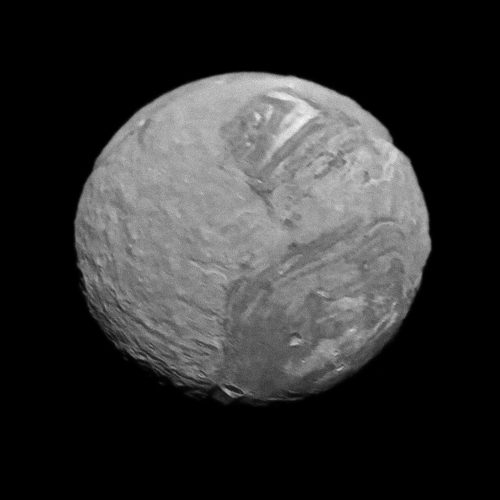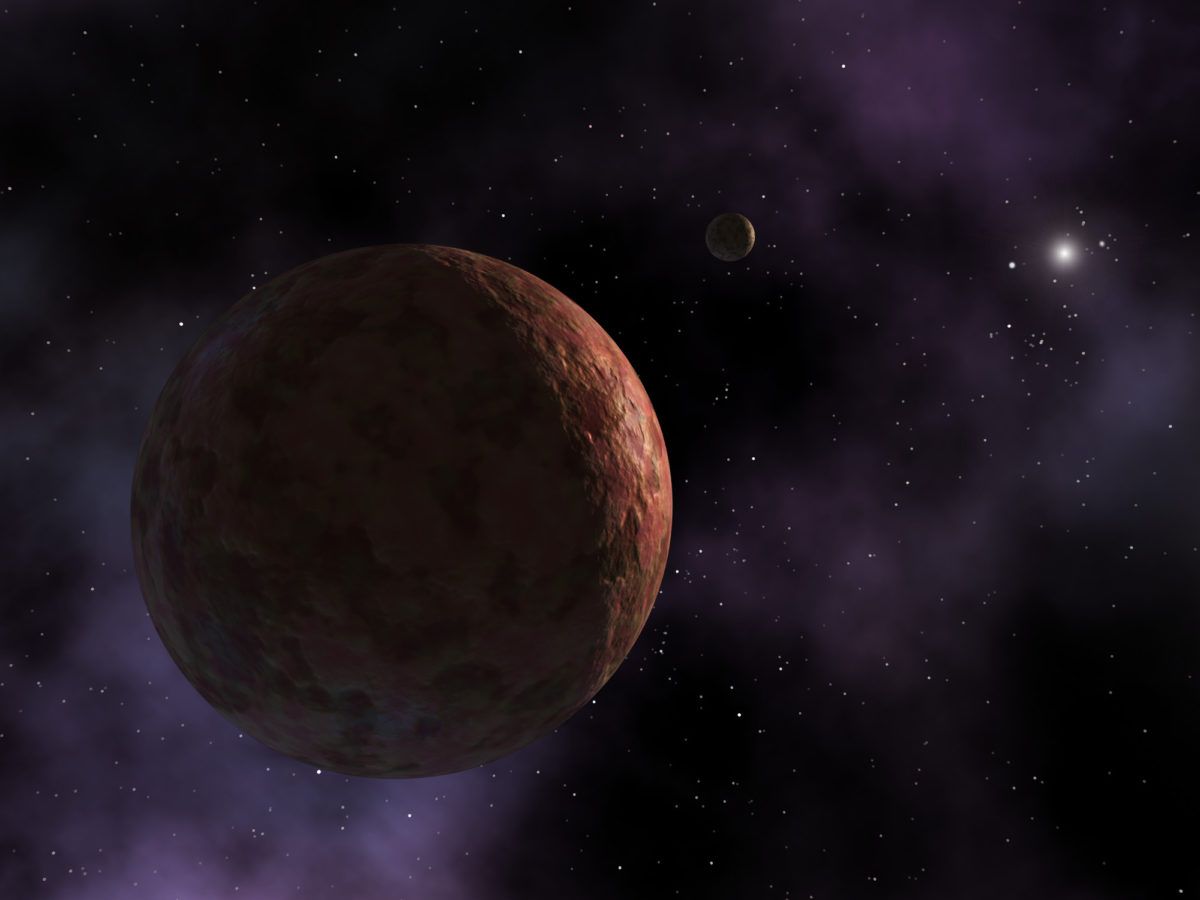Emily Lakdawalla • Jan 11, 2011
Orcus and Vanth
EDIT Jan 14: A reader has pointed out that there was a math error in the ArXiv version of the paper that I summarize in this blog post, which resulted in them estimating a possible mass for Vanth of half that of Orcus. The error was corrected in the final published paper, which is available on Mike Brown's website. More detail explained below.
As part of a big, ongoing project to make a comparison chart of the dimensions and physical properties of solar system objects I've spent the morning tackling the difficult problem of summarizing the physical characteristics of the biggest things that are out there beyond Neptune. These things are very faint and very difficult to study. Consequently, while the sizes and shapes of their orbits and their absolute magnitudes have been nailed down with reasonable precision, very few other "facts" about these bodies are known with any certainty. And it doesn't help that some of these systems are just plain weird.
Take Orcus and Vanth. Orcus, if you haven't heard of it before, is probably the seventh largest known trans-Neptunian object, and Vanth is its satellite. Here's the weird thing I just found out about Orcus and Vanth by reading a 2009 paper by Mike Brown, Darin Ragozzine, John Stansberry, and Wesley Fraser. Vanth could be a biggish moon containing 3% of the mass of the whole system. But it could also be a truly enormous moon containing a third of the mass of the Orcus-Vanth system. For comparison, Pluto's moon Charon, which many of you are probably aware is considered very big compared to its primary, contains only about a tenth of the mass of the Pluto-Charon system.
Brown and his team studied Orcus with both Hubble and Spitzer, two of the greatest observatories. Here are some facts about the Orcus system that are known reasonably precisely.
- Vanth's orbit around Orcus. It's nearly circular, with a period of 9.5393 ± 0.0001 days at a distance of 8980 ± 20 kilometers.
- The total mass of the Vanth-Orcus system. This follows directly from Vanth's orbital period, and is 6.32 ± 0.01 x 1020 kilograms, or, they report, about 3.8% the mass of Eris.
- The brightness of Vanth with respect to Orcus. At visible wavelengths, Vanth is 2.54 ± 0.01 magnitudes fainter than Orcus.
An orbit of only 9000 kilometers is a really really close orbit. Still, Hubble is capable of resolving Orcus and Vanth as two separate (pointlike) objects. What they learned from looking at Orcus and Vanth with Hubble is that the two bodies have verydifferent surfaces. Neither one shows the gray color and strong evidence of water ice that some other Kuiper belt bodies (like Haumea and Charon) do. There's some evidence for some water ice on Orcus, but Vanth looks like more like typical Kuiper belt bodies, reddish in color. It's not the color of Vanth that's odd; it's the fact that Vanth and Orcus have such different colors. In fact, Vanth and Orcus are less similar in color than any other binary pair yet observed in the Kuiper belt.
This dissimilarity in color has various implications for the origin of the Vanth-Orcus system but I'm more interested in what it means about the differences in physical properties between the two. It very likely means that the two have very different albedo, and albedo translates in a very direct way into size.

Size estimates are performed using thermal infrared data, which they got from Spitzer. Unfortunately, Spitzer has lower resolution than Hubble's visible cameras, so it can't resolve Orcus and Vanth separately; all it can see is a single point of light that's composed of light reflected from both Orcus and Vanth. So, for starters, Brown and his coauthors estimated the size that Orcus-Vanth would be if they were, in fact, one object. This comes out to be 940 ± 70 kilometers and 0.28 ± 0.04 for the albedo. That diameter, taken with the relatively well-known mass, produces a density estimate of 1.45 ± 0.3 grams per cubic centimeter, comfortably above the density of ice, meaning it's a mix of rock and ice.
So how big is Vanth relative to Orcus? The usual assumption is that Kuiper belt objects and their satellites have the same albedo, an assumption that's usually been borne out in observations of Kuiper belt binaries. If Vanth and Orcus do have the same albedo, then the fact that Vanth is 2.54 magnitudes fainter than Orcus would imply that Orcus' diameter would be about 900 kilometers, and Vanth would be 3.2 times smaller, 280 kilometers (which is just a bit bigger than Saturn's moon Phoebe).
But I just told you that the Hubble data suggests very different albedo for Vanth and Orcus. The paper says: what if Vanth's albedo is half that of Orcus? Then Orcus would be 820 kilometers in diameter, and Vanth 640 kilometers in diameter, and Vanth would be a "moon" with a whopping 50% the mass of its primary, and would be bigger than the very interesting-looking moons Mimas, Enceladus, and Miranda! This would be even more a binary system, a mutually orbiting dumbell planetoid, than Pluto and Charon are. And it makes me wonder if the story could be even crazier -- if there are reasonable choices for albedo for the two bodies that would actually result in the "moon," Vanth, being larger than its "primary," Orcus. (The preceding discussion was based on the ArXiv version of the paper, which contains a math error. The following discussion is based on the final published version of the paper.) Then Orcus would be 860 kilometers across, and Vanth 380 kilometers, and Vanth would have 1/12 the mass of Orcus, making the system similar in mass ratio to Pluto and Charon.
(Interestingly, these varying diameter estimates don't affect the density estimate much -- the density of both bodies would still be in the neighborhood of 1.5 g/cm3.)
So now I have a conundrum. How the heck do I represent the Orcus-Vanth system on my great big solar system size comparison chart? There's not an easy answer. But that's what makes Orcus and Vanth interesting!
After struggling with trying to pin down the sizes of solar system objects for a long time, I always find myself asking the question, "is size important?" The answer, to me, is yes. It doesn't matter to me how things rank -- I couldn't care less, for instance, whether Pluto is bigger than Eris or not -- but, broadly speaking, size is a critical piece of information that informs us how likely a body is to have interesting geology, and there's a pretty sharp cutoff in the exact neighborhood of Vanth's range of likely diameters, between Phoebe-sized and Miranda-sized bodies, between things that are shaped only by cratering and gravity, and things that are shaped by the consequences of internal heat needing to find some way other than conduction to get out of the middle of a solar system.
Still, since we've never seen any Kuiper belt object up close -- except possibly for a couple of things that might have formed out there in the Kuiper belt but got sent closer to the Sun at some point, namely Triton and Phoebe -- it's impossible to know whether size translates into interesting geology in the same way out there as it does among the moons of the outer planets. For that matter, we've never seen any truly big asteroids up close, either. That's one reason the next few years are going to be so exciting, with Dawn exploring big worlds Vesta and Ceres, and New Horizons exploring Pluto and Charon. My money's on all of these things having interesting geology, and I can't wait to see them!
The Time is Now.
As a Planetary Defender, you’re part of our mission to decrease the risk of Earth being hit by an asteroid or comet.
Donate Today

 Explore Worlds
Explore Worlds Find Life
Find Life Defend Earth
Defend Earth



